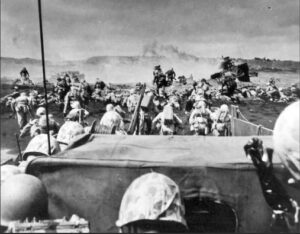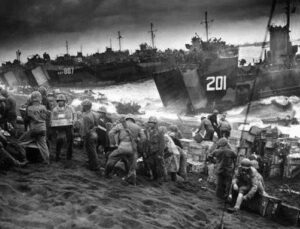
 The taking of vital ground is an important, if not essential part of war. In World War II, Iwo Jima was vital ground. It was prime real estate on which to build airfields to launch bombing raids against Japan, just 660 miles away. The Japanese had it, and the Americans needed it. So, they devised a plan to evict the, then current occupiers, so they could have it. The planned attack was called Operation Detachment, and the plan was to invade Iwo Jima thus putting the Allies in a better position to attack Japan.
The taking of vital ground is an important, if not essential part of war. In World War II, Iwo Jima was vital ground. It was prime real estate on which to build airfields to launch bombing raids against Japan, just 660 miles away. The Japanese had it, and the Americans needed it. So, they devised a plan to evict the, then current occupiers, so they could have it. The planned attack was called Operation Detachment, and the plan was to invade Iwo Jima thus putting the Allies in a better position to attack Japan.
The problem was that Iwo Jima was well fortified, both above and below ground…with a force that was 21,000 strong. The US Marines had to find out where the Japanese strongholds were on the island, so the invasion would take place is several phases. The United States had to be patient in the days leading up to the actual invasion, but they also had to apply pressure to keep the Japanese off guard.
To apply pressure, the Americans began bomber raids using B-24 and B-25 bombers in June 1944. The raids continued for 74 days. It was the longest pre-invasion bombardment of the war. Anytime bombing continues for that long, it has to be stressful for those in the bomb zone. The constant threat of falling bombs, and never knowing if they will land on you next, would make every day stressful. The bombing was necessary because of the extent to which the Japanese fortification of the island, above and below ground, including a network of caves.
Next came the Frogmen phase. “Frogmen” or Underwater Demolition Teams were dispatched by the Americans just before the actual invasion. The plan was to for the frogmen to draw fire from the Japanese, thus giving away many of their “secret” gun positions. Of course, as you can imagine, this was basically a suicide mission for the Underwater Demolition Teams. The amphibious landings of Marines began the morning of February 19, 1945, as the secretary of the navy, James Forrestal, accompanied by journalists, surveyed the scene from a command ship offshore. As the Marines made their way onto the island, seven Japanese battalions opened fire on them. By evening, more than 550 Marines were dead and more than 1,800 were wounded. It took four more days and many more casualties to capture of Mount Suribachi, the highest point of the island and bastion of the Japanese defense. While the taking of Iwo Jima was vital and those who fought and died there willingly gave 
 their lives for it, I have to think that it was a bittersweet victory, because of so many lives lost. Much like the D-Day storming of the beaches of Normandy, Iwo Jima was a suicide mission that was vital to the outcome of the war. The photo of the raising of the American flag on Iwo Jima, won the Pulitzer Prize for the photographer who took it, but I’m sure it was a photograph he would rather not have taken, considering the loss of life.
their lives for it, I have to think that it was a bittersweet victory, because of so many lives lost. Much like the D-Day storming of the beaches of Normandy, Iwo Jima was a suicide mission that was vital to the outcome of the war. The photo of the raising of the American flag on Iwo Jima, won the Pulitzer Prize for the photographer who took it, but I’m sure it was a photograph he would rather not have taken, considering the loss of life.


Leave a Reply